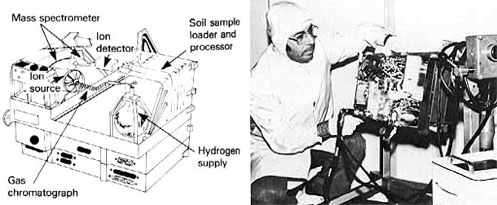Viking gas chromatograph-mass spectrometer

Diagram and photo of the GCMS and associated equipment.
The Viking gas chromatograph-mass spectrometer (GC-MS) was a device carried aboard each of the Viking spacecraft landers in order to detect small concentrations of organic compounds in samples of soil on Mars.
The GC-MS baked a small soil sample in an oven to drive off any volatile gases present, separated these volatiles using a gas chromatograph, and analyzed their composition with a mass spectrometer. It provided a way of resolving any ambiguities that might arise from the three biology experiments – the gas exchange (GEX) experiment, the labeled release experiment, and the pyrolitic release experiment. In particular, the failure of the GC-MS to detect organics would strongly suggest an absence of life whatever were the indications from one or more of the biology tests. On the other hand, the detected presence of organics would not, by itself, constitute evidence for biological activity since many organic compounds (such as those found in meteorites) are abiotic. In the event, the GCMS produced negative results.
Responsibility for GC-MS was with a molecular analysis team, separate from the three biology teams, headed by Klaus Biemann of the Massachusetts Institute of Technology.
Validity of the GC-MS results called into question
The negative finding of any organic material in the sampled Martian soil by the GC-MS was a key factor in the "official" conclusion that, despite some puzzling data, the Viking landers failed to detect life on Mars. Effectively, the argument went, if there were no bodies there could be no life. However, it has subsequently emerged that the GC-MS instrument would probably have been incapable of detecting small concentrations of organic material on Mars even if these were present.
Before Viking ever left the launch pad, the same type of GC-MS that failed to find any organic matter on Mars also failed to detect organic matter on a tested Antarctic soil, despite the fact that a wet chemistry analysis, conducted later, confirmed the presence of organic matter and also the likely presence of microorganisms in Antarctic samples. More recently, the results of the Viking GC-MS have come under more intense scrutiny. In 2000 the chemist Stephen Benner, director of The Westheimer Institute of Science and Technology, pointed out that the Viking GC-MS was not equipped to detect certain organic compounds at all.1 Another criticism of the GC-MS capability was delivered by a team of 12 researchers led by Raphael Navarro-Gonzalez, which reported that the sensitivity of the Viking GC-MS was several orders of magnitude lower than originally thought.2
References
1. Benner, S. A., Devine, K. G., Matveeva, L. N., Powell, D. H. 2000,
"The missing organic molecules on Mars." Proc. Natl. Acad. Sci.
USA, 97, 2425–2430.
2. Navarro-González, R., Navarro, K. F., de la Rosa, J., Iniguez,
E., Molina, P., Miranda, L. D., Morales, P., Cienfuegos, E., Coll, P.,
Raulin, F., Amils, R., and McKay, C. P. 2006, "The limitations on organic
detection in Mars-like soil by thermal volatilization – gas chromatography-MS
and their implications for the Viking results." Proc. Natl. Acad.
Sci. USA, 103, 16089–16094.

